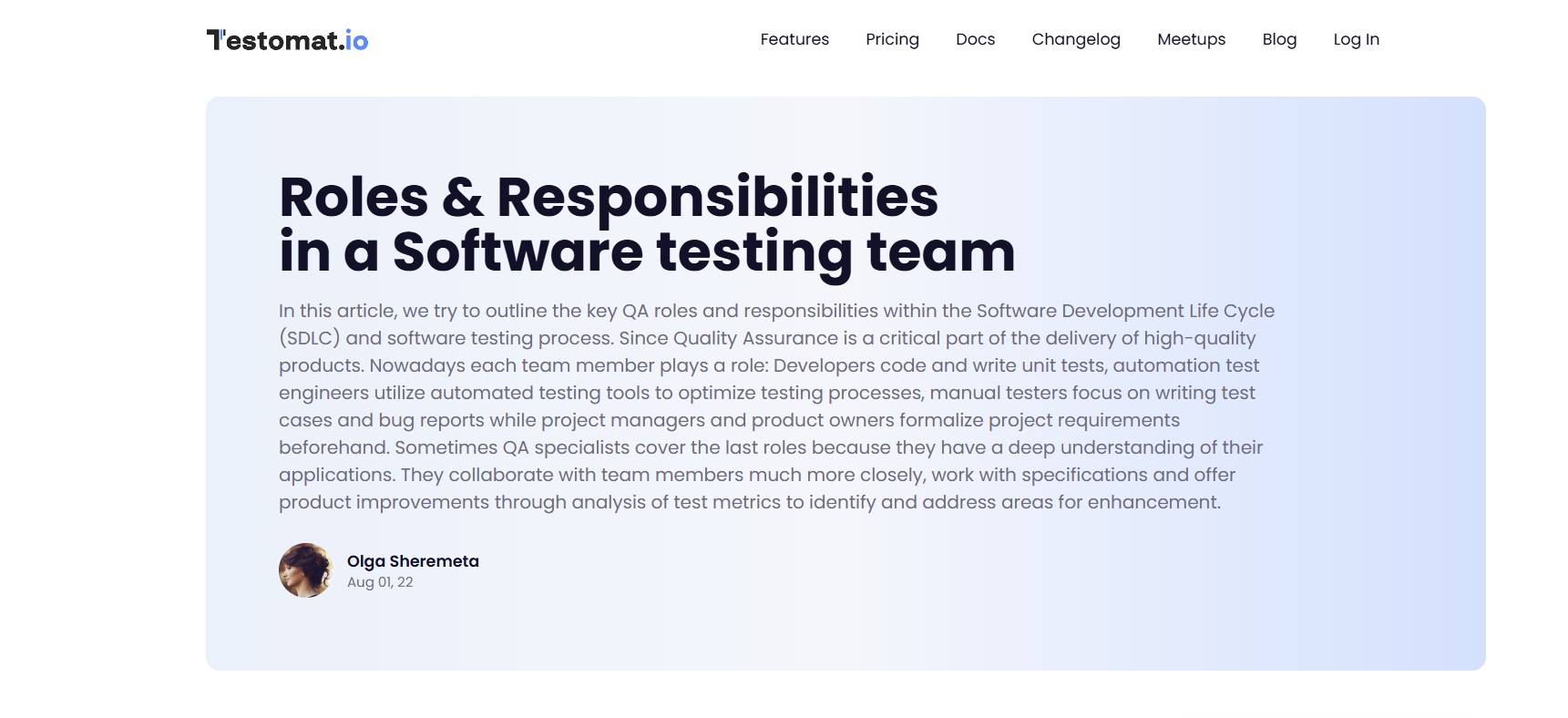Roles and Responsibilities in a Software Testing Team: Key Insights for Building a Successful Testing Team

Strong 8k brings an ultra-HD IPTV experience to your living room and your pocket.
When building a robust software testing team, understanding the roles and responsibilities of each team member is critical for ensuring the quality, efficiency, and effectiveness of the testing process. This comprehensive guide aims to highlight the key roles in a software testing team, outline their responsibilities, and provide insights into how the right structure can positively impact the quality of your software projects. Whether you are forming a new team or looking to optimize your current one, it’s essential to understand the dynamics at play and how each role contributes to the overall success of the testing strategy.
A **software testing team** is an integral part of any development process. It ensures that software applications are reliable, functional, and free of defects before they reach the end-users. The team is responsible for identifying issues early in the development cycle, improving the overall quality of the product, and providing actionable feedback to developers. The effectiveness of this team depends largely on clearly defined roles and responsibilities, collaboration, and leveraging the right tools to streamline testing efforts.
### Why Understanding Roles in a Software Testing Team is Crucial
Before diving into the specifics of each role, it's important to understand why this structure matters so much. A well-organized **software testing team** is critical for:
* **Ensuring Software Quality**: Every aspect of the testing process, from test planning to execution and reporting, requires specialists in various areas of testing.
* **Speeding Up the Testing Process**: With a clearly defined role for each member, the team can efficiently conduct tests in parallel, identify bottlenecks, and avoid delays.
* **Improving Collaboration**: Each team member’s responsibilities overlap with others, fostering a culture of collaboration, which in turn ensures that testing is integrated into the entire development lifecycle.
To understand how to form an effective **software testing team**, it’s important to first explore the various roles within the team and how they contribute to the overall success of the testing process.
### 1. **Test Manager**
The Test Manager is the leader of the **software testing team**. This person is responsible for overseeing the overall testing process, ensuring it is aligned with the project goals, and managing resources effectively. Key responsibilities include:
* **Test Strategy Development**: Defining the testing approach, identifying test deliverables, and ensuring the appropriate tools are in place.
* **Team Management**: Leading the testing team, assigning tasks, tracking progress, and handling any resource-related issues.
* **Stakeholder Communication**: Communicating with project managers, developers, and other stakeholders to ensure testing aligns with business goals and timelines.
* **Risk Management**: Identifying potential risks related to the testing process and mitigating them before they impact the project.
A skilled Test Manager ensures that the testing process is executed smoothly and the team remains focused on the project’s objectives.
### 2. **Test Lead**
The Test Lead works directly under the Test Manager and is often responsible for day-to-day management of the testing efforts. While the Test Manager handles high-level strategic planning, the Test Lead focuses on execution and coordination of the test processes. Their responsibilities include:
* **Test Planning**: Organizing the test execution, designing test plans, and ensuring proper allocation of tasks among the team.
* **Test Execution**: Overseeing the actual testing, ensuring that each test is executed efficiently and accurately.
* **Reporting**: Ensuring that test results are properly documented and communicated to stakeholders.
* **Team Guidance**: Providing guidance and mentorship to junior testers and ensuring adherence to best practices.
The Test Lead acts as the bridge between the Test Manager and the testing team, ensuring the smooth flow of information and timely execution of test activities.
### 3. **Test Analyst**
Test Analysts focus on analyzing the software from the end-user perspective, ensuring that it meets business requirements and performs as expected. Their role involves:
* **Requirements Analysis**: Reviewing project requirements to understand test cases, features, and scenarios that need to be validated.
* **Test Case Design**: Developing detailed test cases and test scripts based on requirements and design documentation.
* **Test Execution**: Conducting manual or automated tests, reporting defects, and verifying fixes.
* **Defect Management**: Identifying and documenting defects, as well as working with developers to ensure issues are addressed.
Test Analysts play a pivotal role in ensuring that the application behaves as expected under different conditions and delivers a quality experience to the end-users.
### 4. **Automation Engineer**
In today’s fast-paced development environment, automation is key to enhancing testing efficiency. Automation Engineers specialize in writing and maintaining test scripts to automate repetitive testing tasks. Their responsibilities include:
* **Automated Test Development**: Creating scripts and frameworks for automating test cases.
* **Automation Tool Selection**: Selecting the appropriate tools (e.g., **Testomat.io**) for automating the testing process.
* **Test Execution and Maintenance**: Running automated tests and updating scripts as the application evolves.
* **Reporting**: Communicating results and providing insights into the performance of the software being tested.
Automation Engineers reduce manual testing effort, enabling the team to perform more tests in a shorter amount of time, thus improving coverage and overall efficiency.
### 5. **Performance Test Engineer**
Performance testing is essential for ensuring that software can handle the expected load and function under stress. Performance Test Engineers focus on testing the scalability and performance of the software under varying conditions. Their responsibilities include:
* **Load Testing**: Simulating heavy usage to determine how the application behaves under stress.
* **Stress Testing**: Pushing the software beyond its limits to identify its breaking points.
* **Monitoring**: Monitoring resource usage, response times, and system stability during performance tests.
* **Optimization**: Identifying performance bottlenecks and working with developers to optimize the software.
The Performance Test Engineer ensures that the application remains responsive and scalable, even under high traffic or challenging conditions.
### 6. **Security Test Engineer**
With growing concerns over cybersecurity, the role of the Security Test Engineer has become more crucial. This role focuses on ensuring that the application is secure and that no vulnerabilities are present. Responsibilities include:
* **Vulnerability Scanning**: Using specialized tools to scan for vulnerabilities in the application.
* **Penetration Testing**: Attempting to exploit weaknesses in the system to identify security risks.
* **Security Protocols**: Ensuring that data is protected through encryption and proper security practices.
* **Risk Assessment**: Identifying and managing security risks and ensuring the application complies with security standards.
Security Test Engineers help safeguard user data and ensure that the software is resilient to attacks.
### Conclusion: Building a Strong Software Testing Team
Building a successful **software testing team** requires understanding the distinct roles and responsibilities that contribute to high-quality testing. By ensuring that your team has clear responsibilities and the right tools, you can significantly enhance your software’s reliability and performance. Incorporating tools like **Testomat.io** can streamline many aspects of the testing process, including test case management, test execution, and collaboration.
For more information on assembling and optimizing a software testing team, you can explore detailed insights in this article: [Roles and Responsibilities in a Software Testing Team](https://testomat.io/blog/roles-responsibilities-in-a-software-testing-team/). Moreover, to learn more about enhancing your testing workflows, don't forget to check out **Testomat** for a comprehensive testing management solution.
By focusing on the right team structure and leveraging the best tools available, you can ensure that your software meets the highest standards of quality and performance.
Note: IndiBlogHub features both user-submitted and editorial content. We do not verify third-party contributions. Read our Disclaimer and Privacy Policyfor details.


